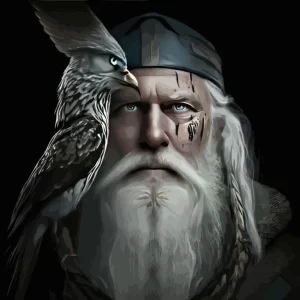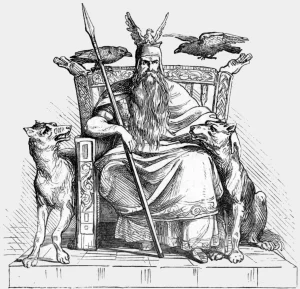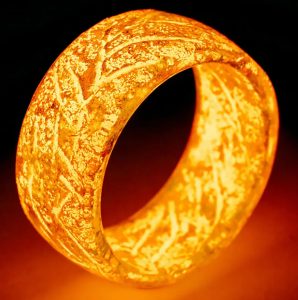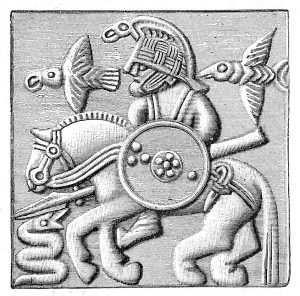Chief of the Norse Gods, Odin had many functions including being a God of war, poetry, wisdom, and death. His halls were called Gladsheim, Valaskjalf and Valhalla. Valhalla is where he gathered his portion of the slain warriors, known as Einheriar (Einherjar), whom the valkyries had chosen.
The valkyries would serve mead which forever flowed from the udder of Odin’s goat, Heidrun. They also served the warriors meat that came from the boar Saehrimnir, which magically came back to life before the next meal. After eating, the warriors would go outside the hall and fight each other to the death. They were, of course, brought back to life before the next feast. All of this fighting was practice for when Odin would lead the Einheriar in the final battle, Ragnarok.
Odin had a spear named Grungir which never missed its mark and a bow which unleashed ten arrows with every pull. He also owned a magic ring called Draupnir (which features on the Odin Estates’ logo), which created nine of itself every night. It was this ring that Odin laid on his son Balder’s funeral pyre and which Balder returned to Odin from the underworld. Another one of Odin’s prized possesions was his wonderful steed named Sleipnir which had eight legs. Odin also had two wolves, Geri and Freki, and two ravens, Hugin [thought] and Munin [memory]. He sent his ravens out every day to gather knowledge for him.
Odin sacrificed himself for knowledge by hanging on the world tree, Yggdrasil, which means Ygg’s horse. Ygg is a name for Odin and horse is a metaphor for the gallows. He thereby learns the runes. Another sacrifice he made for wisdom was his eye. He gave it up in order to drink from the Well of Mimir which bestowed great knowledge. Because of this, he is typically depicted as having one eye. He is also depicted as wearing a cloak, being old, having a long grey beard, and wearing a wide brimmed hat down low over his face to conceal his one-eyed visage.
Odin was destined to die at Ragnarok; Fenris-Wolf swallowed him. Knowing his fate, he still chose to embrace it and do battle. Showing the true warrior ethic. He was the god of warriors and kings, not the common man.



Our logo shows Draupnir which was a gold ring possessed by Odin with the ability to multiply itself (as every ninth night there fell from it eight new gold rings of equal weight). Draupnir was forged by the dwarven brothers Brokkr and Eitri who made this ring as one of a set of three gifts. They made these gifts to win a wager the God Loki made saying that they could not make better gifts than the three made by the Sons of Ivaldi. Loki was clearly a future property developer as he used a loophole to get out of the wager as the wager was for Loki’s head only, but he argued that, to remove his head, they would have to injure his neck, which was not in the bargain!! Brokkr punished Loki by sealing his lips shut with wire.
Huginn and Muninn, sometimes anglicized as Hugin and Munin, are a pair of ravens associated with the Norse god Odin. Hugin and Munin travel the world bearing news and information to Odin. Hugin is “thought” and Munin is “memory”. They are sent out at dawn to gather information and return in the evening. They perch on the god’s shoulders and whisper the news into his ears. It is from these ravens that the kenning ‘raven-god’ for Odin is derived.
The whole world wide, every day,
fly Hugin and Munin;
I worry lest Hugin should fall in flight,
yet more I fear for Munin

